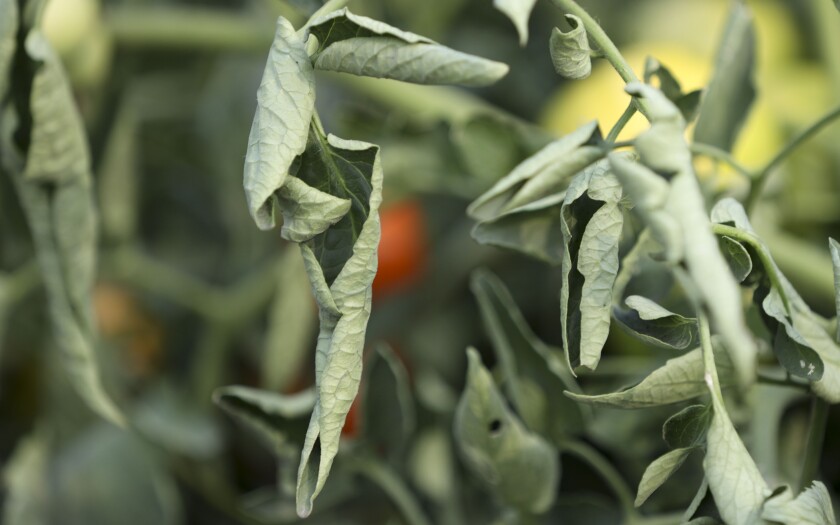Gardening and optimism go together like Martha Stewart and color-coordinated compost bins. We plant a small tree with the anticipation of someday sitting in its shade. We plant tulips in autumn to enjoy spring flowers. We believe our yards and gardens will always be a little better next year with stronger growth and less weeds.
Optimism has been stretched to the limit, though, with this year’s heat and drought. The most noticeable effect on our yards is the crisp brown appearance of many lawns. But the effects of drought and heat go much deeper than a crunchy turf.
ADVERTISEMENT
Drought’s effects are fairly straightforward: plants need water, and without it they suffer or die. Heat is the second component of a hot, dry summer and its effects on plants can be more subtle than drought’s effects.

The following are ways that extended summer heat can dangerously affect plants, based on information from research universities.
- Most plants grow best between 60 and 80 degrees Fahrenheit. If air and soil temperatures are hotter than that for long periods, chemical activity is affected and plant growth slows.
- Even when plants are well-watered, extended summer heat can damage a plant’s photosynthesis system resulting in cell injury and death. Leaf edges can become brown and crisp even when soil is moist.
- Heat can scorch leaves and branches on trees and shrubs, causing early leaf drop and branch dieback.
- Tree roots can shrink away from the surrounding soil as it constricts and cracks in heat and drought, reducing the tree’s ability to take up water.
- Fruit set on tomato, pepper and eggplant is reduced as temperatures climb above the preferred range.
- Heat can reduce pollen viability, causing flower abortion and fruit drop.
- Cucumber, squash, pumpkin and melon vines tend to produce more male blossoms during a hot summer, at the expense of fruit-bearing female blossoms. Female blossoms can be recognized on these crops by the miniature fruits at the flowers’ bases that expand with successful pollination.
- Bulb crops like onions stop expanding in excessive heat, even if moisture is adequate.
- Root crops, such as carrots, are more likely to become knobby, stubby, cracked and less sweet when soil temperature remains high.
- Cool-loving vegetables struggle in heat. Radishes become pithy, lettuce produces unwanted seed stalks and turns bitter, and peas, cabbage and broccoli lose quality.
- Spider mites and certain insects thrive in heat and lack of rainfall.
- Tomato fruits easily develop cracks and blossom end rot in the fluctuating moisture of heat and drought.
- Although tomatoes enjoy warmth, prolonged heat above their preferred threshold delays ripening.
- Tomato leaves frequently roll inward when it’s hot, called physiological leaf roll.
- Apple, tomato, pepper and other fruits easily develop heat-induced sunscald on their exposed side, creating a large yellow or white lesion.
- Many unripe apples are shed prematurely as trees seek to conserve resources for self-survival in heat and drought.
- The size and quantity of blooms on many annual and perennial flowers are reduced by summerlong heat, and blossoms wither rapidly. Scorched leaves are common, even on perennials that are mulched and watered.

Heat stress has caused leaf scorch on many perennial flowers. Michael Vosburg / Forum Photo Editor - Trees, shrubs, flowers and vegetables draw fertilizer nutrients in through their roots in a water solution. Plants can’t draw nutrients from hot, dry, parched soil without adequate moisture. The resulting lack of nutrition weakens plants and depletes stored energy reserves.
- It’s well-documented that certain insects, such as bronze birch borer, are particularly attracted to trees and shrubs stressed by heat and drought.
- Trees, shrubs and perennials that enter winter in a weakened, stressed condition are more likely to suffer winterkill or injury.
- Late summer and early fall will provide an important window for improving the health of our lawns, landscapes and perennial flowers and fruits. In two weeks, this column will discuss how we can help our yards recover from this year’s heat and drought.
Don Kinzler, a lifelong gardener, is the horticulturist with North Dakota State University Extension for Cass County. Readers can reach him at donald.kinzler@ndsu.edu.











